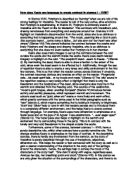How is Romanticism conveyed in Keats To Autumn'?
Is To Autumn a purely descriptive poem?
Keats has made To Autumn a fairly descriptive poem with lots of technical devises to portray the themes he has imbedded throughout. The poem focusses on the season of autumn, set in England in the 1800s and this is obviously conveyed through the language and descriptive phrases he uses.
The first line of the first stanza begins to unravel Keats’ perception of autumn in a very positive way ‘season of mists and mellow fruitfulness.’ Here, Keats is directly addressing autumn, in a rhetorical technique known as an apostrophe. The images used here are very bucolic. The word ‘mist’ portrays the hazy, dimming setting, which is calm and settling. ‘Mellow fruitfulness’ suggests an abundance of ripening fruits, which is what a traditional English autumn tends to bring. This is showing that what Keats is explaining is fruitful and full of nice, sweet things. This period of Keats life (1819) would have been emotionally straining for him. The year prior to him writing To Autumn, his beloved brother died at just 19. Also that same year, Keats met Fanny Brawne and they fell in love. Due to this, Keats may have been in a very emotionally confused state when writing To Autum. He would have been grieving the death of his brother and also having strong feelings of love and passion towards Fanny Brawne, after becoming engaged to her that same year. The poem conveys a sense of peace and a period of Keats life where he had a very clear feeling of settlement with the world and nature around him, almost as if he turned to nature and the naked world as respite from the emotionally staining life he had already lived in such a short space of time. He was very much in touch with nature at this point, and this helps to explain why To Autumn is as personal to Keats as it is. ‘Budding more, And still more.’ The repetition of the word ‘more’ shows how much fruit there is. It helps to portray the abundance that occurs when autumn does. It goes along with the themes set already in the poem of sheer excess and plentitude. The seasons prior to autumn in the 1800 would have been very sparse when it came to fruits and fresh produce, so Keats here clearly highlights just how abundant the autumn is after the periods of struggle and lack of produce.








